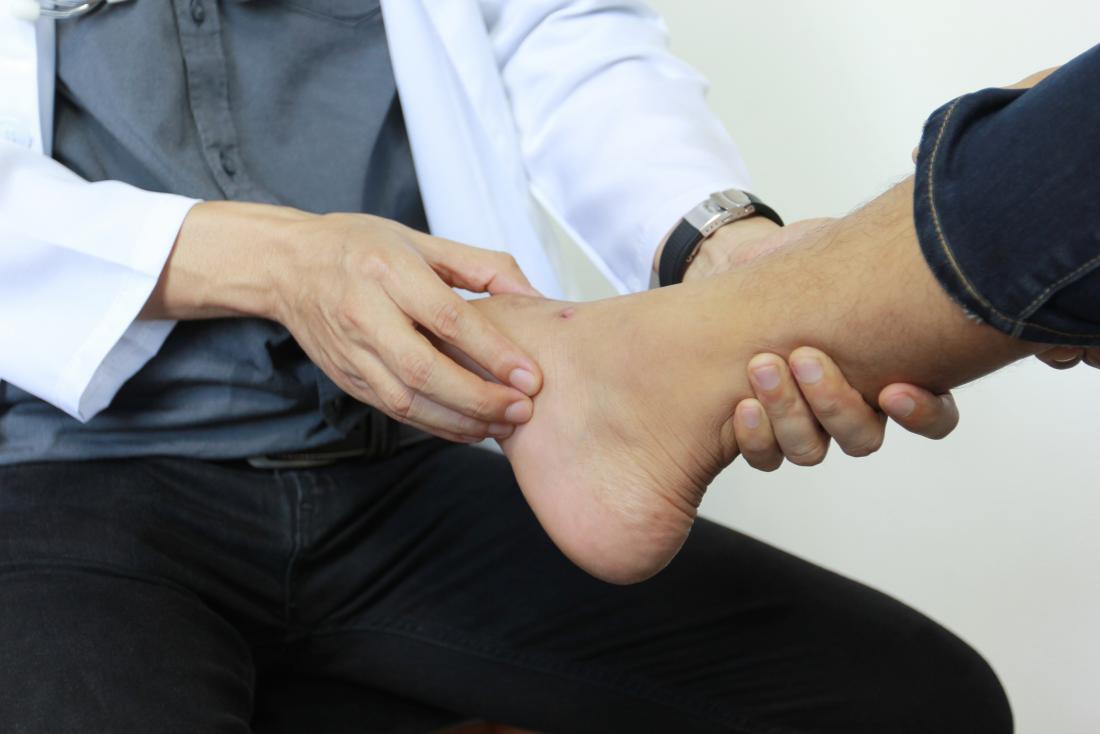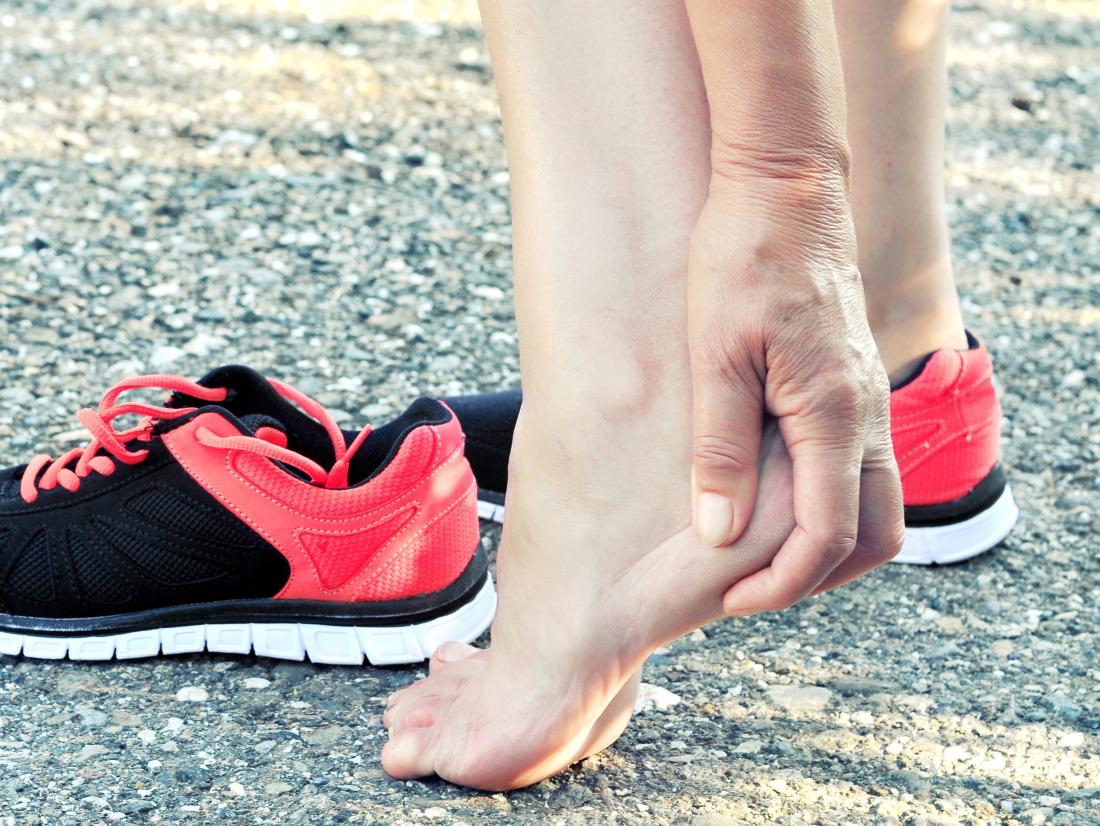Products You May Like
A thick, strong band of tissue called the plantar fascia supports the arch of the foot. This tissue can become damaged or inflamed, causing pain and difficulty moving the foot.
According to the National Institute for Health and Care Excellence, plantar fasciitis accounts for about 80% of cases of heel pain. An estimated 10% of people will experience this problem during their lifetime.
In this article, we provide an overview of plantar fasciitis, including its causes, risk factors, symptoms, and treatments. We also discuss when an individual should see a doctor.
What causes plantar fasciitis?
Regular high impact exercise is a possible cause of plantar fasciitis.
The function of the plantar fascia is to absorb the impact of standing, walking, and running on the foot. This part of the body gets a lot of use, and too much pressure can damage the plantar fascia.
Plantar fasciitis will not necessarily have one single cause. Several risk factors can increase a person’s likelihood of developing the condition. These include:
- age, as plantar fasciitis is especially common in people between the ages of 40 and 60 years
- doing exercise, such as running, that repeatedly impacts the plantar fascia
- having flat feet, high arches, or tight calf muscles
- having overweight or obesity or being pregnant, all of which put more pressure on the feet
- having certain medical conditions, such as arthritis
- frequently standing for extended periods
- often wearing high heeled shoes
Women are more likely than men to experience plantar fasciitis. It is not clear why, but it may be because certain risk factors for the condition — such as pregnancy and wearing unsupportive shoes — affect women more than men.
The condition usually develops with repeated impact or pressure, which, over time, can cause damage to the tissue in the foot.
Symptoms
The plantar fascia runs along the sole from the toes to the bottom of the heel. Excessive pressure on this part of the foot can cause small tears in the tissue. This damage leads to inflammation, pain, and stiffness.
The most common symptom of plantar fasciitis is pain in the plantar fascia. The focus of the pain is usually near the heel, where it can feel as though the tissue is tearing.
The pain may develop gradually over time. It can be worse after a period of rest, for example, first thing in the morning or after a long journey. Alternatively, the pain may worsen after exercise or activity.
Heel spurs are small, bony growths on the bottom of the heel bone. People used to believe that heel spurs were responsible for plantar fasciitis, but they do not cause this pain.
Home remedies
Stretches and exercises that work out the leg or foot muscles can help ease the pain of plantar fasciitis and encourage healing. These exercises include foot flexes, calf stretches, curling a towel between the toes, and picking up marbles with the toes.
Read about exercises and other remedies for plantar fasciitis here.
Resting the foot, applying ice to the area, compressing with a bandage, and raising the foot on cushions or a low stool can help. Nonsteroidal anti-inflammatory drugs can reduce pain and swelling. Some people may find that foot massage also helps alleviate foot pain.
Recovery can take time. After a week or two of rest and home remedies, a person may be able to walk normally without pain. Most people will make a complete recovery from plantar fasciitis within a year.
Lifestyle changes

Investing in supportive shoes may help prevent plantar fasciitis from developing.
Some simple lifestyle changes can help the foot recover and prevent plantar fasciitis from developing again.
Wearing comfortable and supportive shoes can help reduce the daily impact of standing and walking on the feet. The American Academy of Orthopaedic Surgeons provide a guide to choosing the right footwear.
People should replace athletic shoes once they wear out. When the sole of a shoe becomes thinner, it does not provide as much support for the foot or absorb as much impact when the foot hits the ground.
It is also best to choose low impact forms of exercise to help prevent injury. Jogging on a soft surface, such as grass, puts less force on the feet and knee joints than running on the sidewalk. Swimming and yoga can both build strength and flexibility with minimal impact on the body.
Maintaining a healthy weight can also help reduce the pressure that a person puts on their feet. Eating a healthful diet and doing regular gentle exercise are effective ways to manage weight.
Treatments
The most effective treatment for plantar fasciitis is often rest and care at home. If home remedies do not work, a doctor may recommend additional treatment. Most treatments are nonsurgical, with doctors only recommending surgery if other treatments have not worked after a year.
Orthotics
An orthotic is a support or device that can help with musculoskeletal problems, which are those relating to the bones, muscles, and ligaments. Wearing supportive shoes and using orthotics — such as cushioned inserts and heel supports — can help with plantar fasciitis pain. These reduce the impact on the foot when standing or walking.
A night splint
People usually sleep with their feet relaxed and pointing downward. In this position, the heel relaxes, which tightens the plantar fascia. It can also cause the calf muscles to become tight, which can increase arch pain. People can use a night splint to keep the foot flexed overnight.
Physical therapy
Physical therapy can help stretch the muscles to improve the range of movement, reduce pain, and support healing. Massage therapy can help by reducing both pain and inflammation.
Anti-inflammatories
Cortisone is an anti-inflammatory medication. Cortisone injections into the tissue can reduce pain and inflammation. However, it is best to limit the number of injections to minimize the risk of side effects.
Shockwave therapy
Extracorporeal shockwave therapy is a nonsurgical treatment that may stimulate healing. It is low risk and noninvasive, but more research is necessary to confirm whether it is effective.
Surgery
If none of these treatments are effective, a doctor may recommend surgery. Surgery for plantar fasciitis is low risk, but complications can include pain or nerve damage. There are two main options for surgery:
- Gastrocnemius recession lengthens the calf muscles to increase the range of movement in the ankle, reducing stress on the plantar fascia. The surgeon will use either an open method or minimally invasive surgery, which may reduce recovery time.
- Plantar fascia release involves a surgeon making a cut in the plantar fascia to reduce tension. People with a good range of movement in the ankle are better candidates for this procedure.
When to see a doctor

A person should talk to their doctor if plantar fasciitis does not improve with home remedies.
If pain is ongoing and does not improve with home remedies, it is important to see a doctor. Ignoring plantar fasciitis can lead to ongoing pain and possible damage to structures in the foot.
A doctor will usually ask the individual about their symptoms and medical history, as well as any lifestyle factors that may have contributed to the problem. They may also wish to know the exact location of the pain and whether it is worse at certain times of the day or after exercise.
The doctor will then examine the foot to look for signs of plantar fasciitis. These can include:
- pain or tenderness in front of the heel bone
- pain that worsens when flexing the foot and applying pressure to the plantar fascia
- a limited range of movement in the ankle
After making a diagnosis, the doctor will be able to recommend treatment options.
Summary
Plantar fasciitis can cause significant pain and difficulty moving the foot normally. However, most people make a complete recovery from the condition.
Treating plantar fasciitis with home remedies and simple lifestyle changes is usually effective. A person can reduce the risk factors by engaging in low impact exercise, wearing appropriate footwear, and maintaining a healthy body weight.
